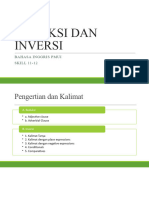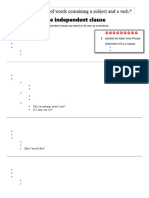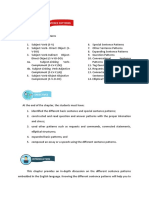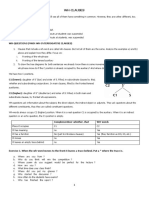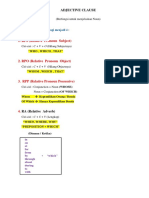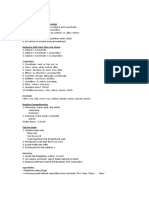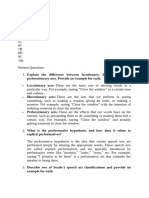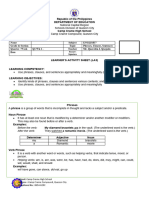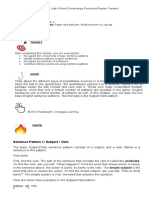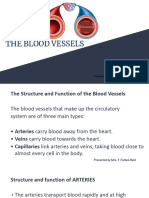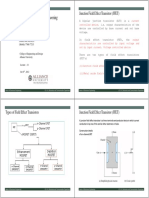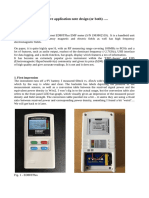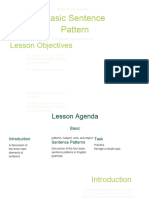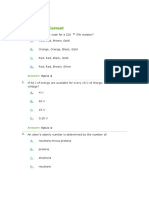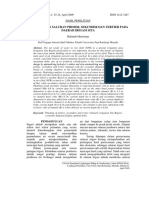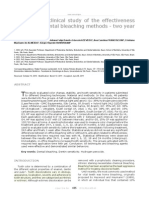0 ratings0% found this document useful (0 votes)
83 viewsA. Perbedaan Adjective Clause Dan Noun Clause
A. Perbedaan Adjective Clause Dan Noun Clause
Uploaded by
wisnu girindratamaThis document discusses noun clauses and their functions as subjects or objects. It provides examples of different types of noun clauses introduced by conjunctions like who, whom, which, what, whose, when, where, why, that, how, if, whether. It notes that "that" is the only conjunction that can be omitted when the noun clause is the object. It also explains that a noun clause can be abbreviated to an infinitive phrase if the conjunction is a question word, the subjects are the same, and the subclause contains a modal verb.
Copyright:
© All Rights Reserved
Available Formats
Download as PDF, TXT or read online from Scribd
A. Perbedaan Adjective Clause Dan Noun Clause
A. Perbedaan Adjective Clause Dan Noun Clause
Uploaded by
wisnu girindratama0 ratings0% found this document useful (0 votes)
83 views3 pagesThis document discusses noun clauses and their functions as subjects or objects. It provides examples of different types of noun clauses introduced by conjunctions like who, whom, which, what, whose, when, where, why, that, how, if, whether. It notes that "that" is the only conjunction that can be omitted when the noun clause is the object. It also explains that a noun clause can be abbreviated to an infinitive phrase if the conjunction is a question word, the subjects are the same, and the subclause contains a modal verb.
Original Description:
Resume noun clause
Original Title
3 Noun Clause
Copyright
© © All Rights Reserved
Available Formats
PDF, TXT or read online from Scribd
Share this document
Did you find this document useful?
Is this content inappropriate?
This document discusses noun clauses and their functions as subjects or objects. It provides examples of different types of noun clauses introduced by conjunctions like who, whom, which, what, whose, when, where, why, that, how, if, whether. It notes that "that" is the only conjunction that can be omitted when the noun clause is the object. It also explains that a noun clause can be abbreviated to an infinitive phrase if the conjunction is a question word, the subjects are the same, and the subclause contains a modal verb.
Copyright:
© All Rights Reserved
Available Formats
Download as PDF, TXT or read online from Scribd
Download as pdf or txt
0 ratings0% found this document useful (0 votes)
83 views3 pagesA. Perbedaan Adjective Clause Dan Noun Clause
A. Perbedaan Adjective Clause Dan Noun Clause
Uploaded by
wisnu girindratamaThis document discusses noun clauses and their functions as subjects or objects. It provides examples of different types of noun clauses introduced by conjunctions like who, whom, which, what, whose, when, where, why, that, how, if, whether. It notes that "that" is the only conjunction that can be omitted when the noun clause is the object. It also explains that a noun clause can be abbreviated to an infinitive phrase if the conjunction is a question word, the subjects are the same, and the subclause contains a modal verb.
Copyright:
© All Rights Reserved
Available Formats
Download as PDF, TXT or read online from Scribd
Download as pdf or txt
You are on page 1of 3
NOUN CLAUSE
Berfungsi sebagai Subject / Object
A. Perbedaan Adjective Clause dan Noun Clause
Adjective Clause Conjunction-nya jatuh setelah Noun, karena berfungsi
menjelaskan Noun.
Noun Clause Conjunction-nya tidak jatuh setelah Noun.
Conjunction-nya biasanya berdiri di depan atau jatuh
setelah verb/preposition karena fungsinya sebagai
Subject/Object.
B. Pola Noun Clause
1. Who = Siapa yang Verb : Pengganti Orang
2. Whom = Siapa yang S+V : Pengganti Orang
3. Which = Mana yang N / S+V / V : Pilihan Benda
4. What = Apa yang N / S+V / V : Menyatakan Jenis
5. Whose = Yang (N) nya N / S+V / V : Menyatakan Kepemilikan
6. When = Ketika S+V : Menyatakan Waktu
7. Where = Dimana S+V : Menyatakan Tempat
8. Why = Kenapa S+V : Menyatakan Alasan
9. That = Bahwa S+V : Menjelaskan Pernyataan
10. How = Bagaimana S+V : Metode / Proses / Cara
11. If = Apakah S+V : Menyatakan 2 Pilihan
12. Whether = Apakah S+V : Menyatakan 2 Pilihan
Examples:
1. KPK is investigating who smuggled BOS fund last year.
2. Whom we helped in the past will help us in the future.
3. The Minister of Education is considering which curriculum is
appropiate.
Which one do you like of these food?
4. The doctor does not mention what treatment is used to cure disease.
What makes me happy today is knowing that I get the scholarship.
5. We are wondering whose child is crying in the park.
Whose IELTS score is under 6,5 can not register the scholarship.
6. I remember when The Earthquake strucked Yogyakarta
7. The police is interrogating where the criminals hide the evidence.
8. Why the company is bankrupt is not known by many people
9. Many people realize that Education is an important aspect to increase
people’s life quality.
10. We are thinking about how Indonesia can be free from corruption.
We are thinking about how to fight corruption in Indonesia.
11. Some of the students in Pare have not decide if they will study TOEFL or
IELTS.
12. The scientists have wondered whether life exists or not elsewhere in the
universe.
C. Omitting and Abridgement in Noun Clause
1. Omitting
From all of the conjunctions in NC, “That” is the only conjunction that
can be omitted when “that” becomes “object”.
examples:
I agree that education is essential for our life.
I agree education is essential for our life.
2. Abridgement
Abridgement is changing noun clause to be “to infinitive”
To infinitive
The requirements:
a. The conjunction is from question word
b. Subject in sub clause is similar to subject in main clause
c. In sub clause, there must be “modal” such as “can, must,
should”
Examples:
I don’t know what I should do / I don’t know what to do
You might also like
- Titik Nol English Course: Noun ClauseDocument1 pageTitik Nol English Course: Noun ClauseariniNo ratings yet
- Titik Nol English Course: Noun ClauseDocument1 pageTitik Nol English Course: Noun ClauseIqbal AlviannurNo ratings yet
- Noun Clause: Berfungsi Sebagai Subject / Object / Object of PrepositionDocument2 pagesNoun Clause: Berfungsi Sebagai Subject / Object / Object of Prepositionria.janitaNo ratings yet
- A. Problem Background: OpeningDocument8 pagesA. Problem Background: OpeningHono JoeNo ratings yet
- Day TwoDocument15 pagesDay TwoN Siti MariamNo ratings yet
- Pertemuan 10 - Noun Clause and Adverb ClauseDocument12 pagesPertemuan 10 - Noun Clause and Adverb Clauserama amazingNo ratings yet
- 4th Meeting (Reduksi Dan Inversi)Document36 pages4th Meeting (Reduksi Dan Inversi)Riska AyuNo ratings yet
- Topics GrammarDocument8 pagesTopics GrammarDepiiNo ratings yet
- clauses typesDocument13 pagesclauses typesa.elbouazzaoui1567No ratings yet
- Noun ClausesDocument16 pagesNoun ClausesMarilyn Cubero GonzálezNo ratings yet
- Ii. Subject Matter: Topic: Using Imperatives and Prepositions in Giving Clear Instructions Reference: Grade 7 Learning ModuleDocument6 pagesIi. Subject Matter: Topic: Using Imperatives and Prepositions in Giving Clear Instructions Reference: Grade 7 Learning ModuleGabriel Francisco100% (1)
- Adj Clause PDFDocument1 pageAdj Clause PDFwisnu girindratamaNo ratings yet
- Subordinadas de Relativo Ejercicios Inglés Def y Non DefDocument2 pagesSubordinadas de Relativo Ejercicios Inglés Def y Non Defsaramorcillo100% (1)
- Clauses TypesDocument14 pagesClauses Typesa.elbouazzaoui1567No ratings yet
- 3 - ClausesDocument35 pages3 - ClausesKosorl DowmNo ratings yet
- Toefl 3Document13 pagesToefl 3YzifarNo ratings yet
- Skill ToeflDocument70 pagesSkill ToeflSaepul RochmanNo ratings yet
- Part of Sentence and Noun ClausesDocument9 pagesPart of Sentence and Noun ClausesSyahri FaziraNo ratings yet
- Clauses Types and Function LessonDocument4 pagesClauses Types and Function Lessonnailachettouh1No ratings yet
- Adjective ClauseDocument7 pagesAdjective ClauseDewi Anastasia PandianganNo ratings yet
- Judy Hubbards ExercisesDocument38 pagesJudy Hubbards ExerciseskrishnachivukulaNo ratings yet
- Adjective and Noun ClauseDocument5 pagesAdjective and Noun ClauseMutiara Kholizah BatubaraNo ratings yet
- 09 - Chapter 3 PDFDocument71 pages09 - Chapter 3 PDFSky JadhavNo ratings yet
- Noun Clause - A2ZDocument29 pagesNoun Clause - A2ZSamsul ArifinNo ratings yet
- Terima Kasih Saudara Menjawab Dengan Jujur. Selamat Bekerja'Document12 pagesTerima Kasih Saudara Menjawab Dengan Jujur. Selamat Bekerja'elsa lestariNo ratings yet
- Chapter-5 Sentence Patterns 21Document16 pagesChapter-5 Sentence Patterns 21Joemar BenitoNo ratings yet
- Lesson Plan in Demo Teaching DICENDocument8 pagesLesson Plan in Demo Teaching DICENPhilip Jan PuerinNo ratings yet
- Pengertian Adjective Clause Meeting 9Document5 pagesPengertian Adjective Clause Meeting 9Aulia ZonaasriNo ratings yet
- Words, Phrases, Clauses, SenencesDocument11 pagesWords, Phrases, Clauses, Senenceszunairah919No ratings yet
- Working For A Living - LISTENINGDocument10 pagesWorking For A Living - LISTENINGnguyen anNo ratings yet
- Some Useful Structrues in Ielts WritingDocument5 pagesSome Useful Structrues in Ielts WritingThể Phan ThịNo ratings yet
- Grammar Module - 4Document29 pagesGrammar Module - 4Ella YahalabNo ratings yet
- NOUN CLAUSES-answers p1-6Document7 pagesNOUN CLAUSES-answers p1-6Salih Can ŞenNo ratings yet
- Lesson PlanDocument7 pagesLesson PlanSharmeni DionesNo ratings yet
- Sentence Constituents & Word Order: Muthia Andini Rinawati Pelawi Sri Susanti Trihartina Tampubolon Weby YolannisaDocument88 pagesSentence Constituents & Word Order: Muthia Andini Rinawati Pelawi Sri Susanti Trihartina Tampubolon Weby YolannisaWeby YolannisaNo ratings yet
- Get To Know All The Basics of English!Document12 pagesGet To Know All The Basics of English!Fadhila EriandaNo ratings yet
- Sentences Second PartDocument7 pagesSentences Second PartMagalí StylesNo ratings yet
- Efpc - Tugas Pengganti - Indra S - 17302241042Document7 pagesEfpc - Tugas Pengganti - Indra S - 17302241042Indra SNo ratings yet
- Lesson Plan in Demo Teaching DICENDocument7 pagesLesson Plan in Demo Teaching DICENPhilip Jan PuerinNo ratings yet
- Buku TOEFL 2 HoursDocument31 pagesBuku TOEFL 2 HoursruNo ratings yet
- RPS (Relative Pronoun Subject) : Adjective ClauseDocument2 pagesRPS (Relative Pronoun Subject) : Adjective ClauseIqbal AlviannurNo ratings yet
- Makalah Bhs Inggris 4Document14 pagesMakalah Bhs Inggris 4arifinNo ratings yet
- Noun ClauseDocument6 pagesNoun ClauseIndahNo ratings yet
- Subjects and Predicate QuizDocument2 pagesSubjects and Predicate Quizapi-234755714No ratings yet
- Structure and Written Expression: ConjuntionDocument4 pagesStructure and Written Expression: ConjuntionMuhamad TaufiqurahmanNo ratings yet
- Practice Toefl - Chapter 4Document7 pagesPractice Toefl - Chapter 4Haifa NurhandiniNo ratings yet
- ReportDocument8 pagesReportBraxton GoffNo ratings yet
- Grammar ProjectDocument24 pagesGrammar Projectphamtranmanhcuong2005No ratings yet
- Đoàn Đỗ Thành Đạt-472609Document3 pagesĐoàn Đỗ Thành Đạt-472609doanthanhdat3012No ratings yet
- Semi-DLP ConditionalsDocument3 pagesSemi-DLP ConditionalsEvangeline IminganNo ratings yet
- Adverbial N Noun ClausesDocument6 pagesAdverbial N Noun ClausesLuthfia AtikasariNo ratings yet
- Noun ClauseDocument3 pagesNoun ClauseREUA08No ratings yet
- Lesson Plan Week 8Document3 pagesLesson Plan Week 8Ellamay RecodigNo ratings yet
- PHRASES, CLAUSES, SENTENCES For ModularDocument7 pagesPHRASES, CLAUSES, SENTENCES For ModularQUEROBIN QUEJADONo ratings yet
- Task 1 & Task 2 Highly Important Sentence StructuresDocument22 pagesTask 1 & Task 2 Highly Important Sentence StructuresRizwan Bashir100% (1)
- Active and Passive Voice & Argumentative ClaimsDocument33 pagesActive and Passive Voice & Argumentative ClaimsQui RainNo ratings yet
- Al Amalus Sulwana - 2011080008Document9 pagesAl Amalus Sulwana - 2011080008Al Amalus SulwanaNo ratings yet
- After Completing This Module, You Are Expected ToDocument5 pagesAfter Completing This Module, You Are Expected ToMark Lawrence Manlegro100% (1)
- Ielts Writing Task 2 Course Book FoundationDocument13 pagesIelts Writing Task 2 Course Book FoundationkaoknboNo ratings yet
- Writing with Clarity and Accuracy: The Grammar You Need, Level 3From EverandWriting with Clarity and Accuracy: The Grammar You Need, Level 3Rating: 5 out of 5 stars5/5 (1)
- Iare - Fluid Mechanics - Tutorial - Question - Bank PDFDocument12 pagesIare - Fluid Mechanics - Tutorial - Question - Bank PDFShaik Asif AliNo ratings yet
- Experiment 2 Formal Lab ReportDocument6 pagesExperiment 2 Formal Lab Reportapi-531389722No ratings yet
- g7m1l10 - Equations of Graphs of Proportional Relationships Involving FractionsDocument8 pagesg7m1l10 - Equations of Graphs of Proportional Relationships Involving Fractionsapi-276774049No ratings yet
- Unit-II Second Law of ThermodynamicsDocument41 pagesUnit-II Second Law of Thermodynamicssamy gsNo ratings yet
- HP Compaq 6005 Pro Business PC Data Sheet Mar UpdateDocument4 pagesHP Compaq 6005 Pro Business PC Data Sheet Mar UpdateCasey StrachanNo ratings yet
- The Blood VesselsDocument19 pagesThe Blood VesselswallacedaniyahbNo ratings yet
- Basics of Electronic Engineering: Junction Field Effect Transistor (JFET)Document4 pagesBasics of Electronic Engineering: Junction Field Effect Transistor (JFET)Esty YustyNo ratings yet
- Tutorial 18 3D Tunnel Simulation Using Core ReplacementDocument27 pagesTutorial 18 3D Tunnel Simulation Using Core ReplacementAleksandar Milidrag100% (2)
- Approaches For Anomaly Detection in Network - ADocument6 pagesApproaches For Anomaly Detection in Network - Aouarme.arNo ratings yet
- D464 Formula SheetDocument13 pagesD464 Formula Sheetyomaira.bastidas.ysNo ratings yet
- Configuring The Metadata Card (M-Files 2018 and M-Files Online)Document42 pagesConfiguring The Metadata Card (M-Files 2018 and M-Files Online)Thomas SaréaNo ratings yet
- ED88TPlus Teardown - FinalDocument6 pagesED88TPlus Teardown - FinalLauri PitkäjärviNo ratings yet
- Arithmetic Sequences PDFDocument4 pagesArithmetic Sequences PDFCharmz Jhoy100% (1)
- Lecture 2 Chromatography TLC ColumnDocument21 pagesLecture 2 Chromatography TLC ColumnSherdil khanNo ratings yet
- Final Project AkshayDocument63 pagesFinal Project AkshayGovind WakchaureNo ratings yet
- Basic Sentence PatternDocument11 pagesBasic Sentence PatternJasmin AjoNo ratings yet
- Tutorial 4Document2 pagesTutorial 4Jaeson SisonNo ratings yet
- IB Physics 2 Summer Refresh WorkDocument25 pagesIB Physics 2 Summer Refresh WorkJeffNo ratings yet
- INDIABIXDocument314 pagesINDIABIXvon kervy onradeNo ratings yet
- АТ6103 Mobile Radiation Scanning System: ApplicationDocument4 pagesАТ6103 Mobile Radiation Scanning System: ApplicationHari NurcahyadiNo ratings yet
- Educ 420 Lesson Plan 3 Two-Digit Addition With RegroupingDocument2 pagesEduc 420 Lesson Plan 3 Two-Digit Addition With Regroupingapi-302683612100% (1)
- JM Ekoton,+Hal+25 34+Halimah+Masloman+Word+2003Document11 pagesJM Ekoton,+Hal+25 34+Halimah+Masloman+Word+2003digatoadsNo ratings yet
- Savitribai Phule Pune University: Timetable For Fresh & Backlog Online Examination of October/November 2021Document9 pagesSavitribai Phule Pune University: Timetable For Fresh & Backlog Online Examination of October/November 2021sunny kumarNo ratings yet
- Materials and Methods-5Document12 pagesMaterials and Methods-5wenhsiaochuanNo ratings yet
- Construction MaterialsDocument52 pagesConstruction MaterialsManoj QNo ratings yet
- Rubber Hose: Standard Test Methods ForDocument10 pagesRubber Hose: Standard Test Methods ForAMUL VEKARIANo ratings yet
- DLL Math 2nd QTR WK 1 Day 3Document7 pagesDLL Math 2nd QTR WK 1 Day 3Mary Ann PimentelNo ratings yet
- Authors Research Setting Sample Methods of Data Collection and Analysis Variables Investigated (Must Relate To Your Study) FindingsDocument1 pageAuthors Research Setting Sample Methods of Data Collection and Analysis Variables Investigated (Must Relate To Your Study) FindingsSyai GenjNo ratings yet
- Wind Tunnel A Research ToolDocument9 pagesWind Tunnel A Research ToolMohammad NasreddineNo ratings yet
- Jaos-20-04-0435 2010 PDFDocument9 pagesJaos-20-04-0435 2010 PDFAshley Liliam Pedrozo CordobaNo ratings yet






